 Go
to the Archive index
Go
to the Archive indexCrossing the time portal, our door closes behind us, then we step down the street of a new morning in an old year. Dry autumn leaves dance in the breeze as we cross the road to a newsstand on the corner to buy a paper with an old copper from our pocket. A curious eye is drawn to the date at the top of the page: 1958! This is the dark age of motorised cycling! The last autocycle became extinct in July as BSA discontinued its restyled New Hudson, while the few surviving cyclemotors are gradually fading from the listings. The moped is emerging victorious from this battle, but who will become the people's champion in the coming moped war?
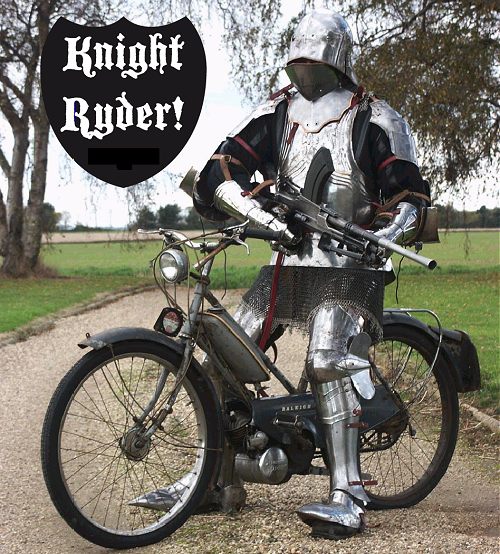
Tube Investments should be favourite, with all the factories that comprise the British Cycle Corporation. Norman's Nippy and Cyclemate models have proved fairly popular and the futuristic Lido is shortly to be announced. Phillips continues selling the P39 Gadabout well, but Hercules has recently lost its JAP engine for the Her-cu-motor and is now faced with having to develop a new bike. TI bought out Aberdale, only to withdraw the Bown 50, and the Dunelt Reynolds moped has completely failed to materialise, so they don't really have very much to contend against the rising continental tide. In truth, UK moped sales are presently dominated by imported machines, with NSU heading the charge. The home market is wide open and a new knight is poised to join battle! Making their last motor cycles in 1933, after 35 years in the wilderness, The Crusader Returns - Raleigh comes home!
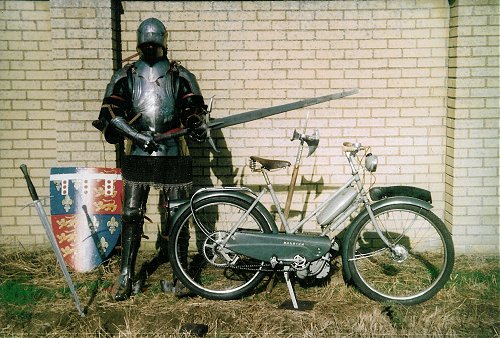
The new Raleigh RM1 moped was announced at the London Savoy in October of 1958, to be introduced from November. The original crankcase of today's feature machine is dated 11-58, so among the very first of this new model. The Sturmey Archer engine is new - well, sort of! Made for Raleigh by BSA, the motor had been drafted by Vincenzo Piatti, and features his characteristic deep ported transfer system. While actually sharing a compatible piston with the Trojan cyclemotor engine, Piatti's reworking of his old Mini-Motor for Raleigh fails to improve on the earlier design. In a backstep to cheap old-fashioned practice, the crank is overhung from one ball race, and steadied inside the drive side with a needle roller bearing. It's a horrible design having both the bearings in the middle of the crankshaft with the flywheel, belt pulley and Lucas mag whirling around on the ends. A pretty sure formula for vibration!
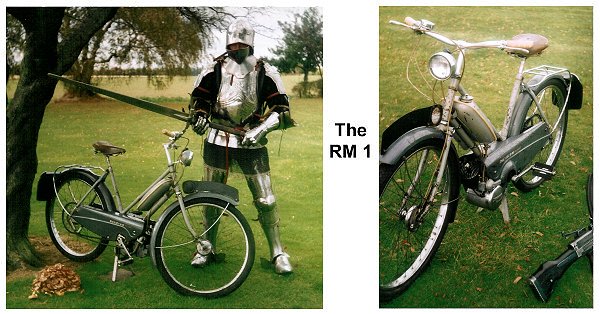
Next comes Raleigh's contribution: the cycle frame is based on a heavy gauge lady's bicycle with rigid rear and rigid fork, leaving the 26" wheels with their new 26"×2" pneumatic tyre size providing the only suspension effect. Transmission travels via belt to a first reduction flywheel running on the LH pedal crank, crossing to chain final drive taken from the RH crank side, which also runs the pedal chain on the same side! You may observe a particularly significant omission in this: no clutch or gears!
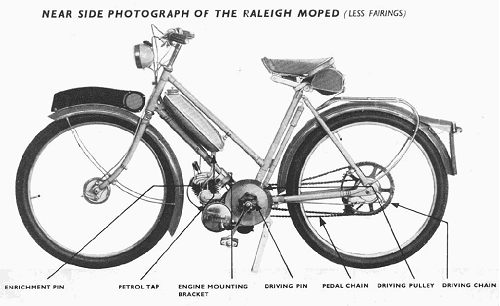
Unbelievable as it may seem, Raleigh was proposing to enter the market with a direct drive moped as late as 1958! Considering such a primitive device, how could they possibly hope to compete against NSU's famous Quickly, the Norman Nippy with its fine Sachs 2-speed engine, or the elegance of the Phillips Gadabout and its superb Rex motor? Raleigh's master plan was simply to square up to them on cost - the RM1 would sell on price alone at £48-16s-6d, the only cheaper moped on the market at the time being the most basic direct drive Mobylette for £45-10s-11d (though the 32cc Cyclemate was still available at £37-10-9d, and that included a clutch!) Most other mopeds of the time were priced upwards of £55, so coming in at less than £50 would have been quite a feature. The other card to play for their advantage would be availability; the new RM1 moped could be offered through practically every distribution outlet already selling Raleigh bicycles.
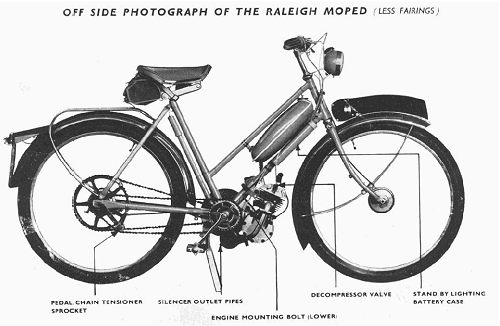
OK, so we've wandered down to our local branch of Curry's and bought a new cheap and nasty Raleigh moped, but getting going on our RM1 requires consideration of a few of the unconventional features. Since the bike is more easily wheeled about in pedal mode, it's necessary to push in the driving pin on the flywheel to engage the engine. Any further navigation in drive mode requires the Amal twistgrip holding forward to decompress. Choke operation on the 3/8" Amal 385/1 carburettor is engaged by lifting a flood lever and, due to a thirst for a rich mixture when cold, it may prove necessary to repeat the starting procedure two or three times. Since it's not possible to reach and operate the flood choke from the riding position, and unsure whether the motor will die if you just pedal it straight off down the road, it becomes more common practice to start and warm-up on the cast aluminium Suresta centre stand. With the motor now revving cleanly on the stand, it's as well to make a point of remembering this is a direct-drive machine - before you push it off! Stop the motor with the decompressor, nudge off the stand, and restart by pedalling along the road.
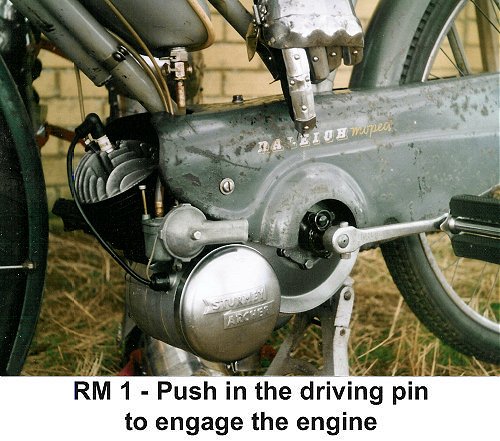
The Sturmey-Archer motor labours away pretty well at low revs, so the lack of a clutch really isn't much of an issue as long as you continue moving, and the slow phase can always be helped by a bit of pedalling - very similar to many cyclemotors. The engine requires building well up to temperature before it starts to perform properly, which usually takes some 5 miles. The firm cycle frame handles well on smooth surfaces, but is also very light and features no suspension beyond the tyres, so transmits a fair battering if the road cuts up rough. Due to the RM1's tall gearing and low output (6.2:1 compression, giving 1.3bhp at 4,300rpm), top speed is only achievable on the flat with a tailwind, or downhill. Pace bike clocked its peak to a remarkable 36mph, at which the pilot certainly feels every one of them! The motor is howling in a tormented shriek of agony as the whole bike vibrates, rattles and buzzes like it's just about to fall to pieces down the road. The pilot develops double vision, and the fillings start to fall out of his teeth! Yes, it's definitely flat-out! Easing back from a top speed run is a relief of survival for both rider and bike. The brakes are generally adequate at a reasonable pace, but do seem to fade under pressure, so are probably best not to be relied upon for emergencies.
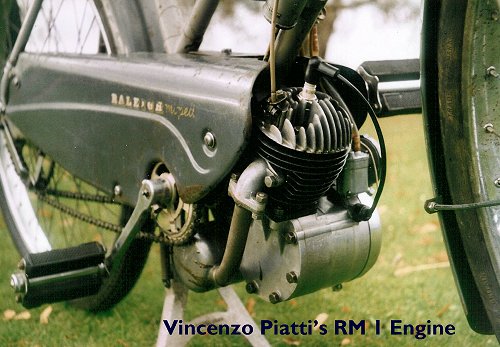
On unlit roads, the Lucas generator lighting proves hopelessly inadequate. It's just not bright enough to see where you're going at whatever speed you're travelling at and, when you slow down, the lamp gets even dimmer - Catch 22! The other 'stand by lighting' set is powered from three 1.5V dry cell batteries in a canister under the right hand side of the petrol tank, but is no more than a cycle system that's only intended to meet old legal requirements for 'night time parking lamps'.
For country riding and general rally usage the lack of a clutch is barely noticeable, but for town use it's a real pain since, if you need to stop the bike at a junction,the engine stops with it. You quickly come to appreciate fine techniques of judging traffic and trickling along in order to keep the engine running, since the worst part is never knowing whether the temperamental motor will actually restart once you've had to stop it. The RM1 is basically a cyclemotor with a chain drive to eliminate the dreaded roller slip, but you really have to wonder what Raleigh was thinking of to introduce such a crude machine as late as 1958. Unlike a cyclemotor with its motor disengaged, the RM1 suffers massive drag from the pedalshaft sleeve arrangement, and is utterly exhausting to pedal in cycle mode. It certainly sold in significant numbers, but was not a popular success since customers were expecting much more in the later 1950s, even when it came at such a low cost.
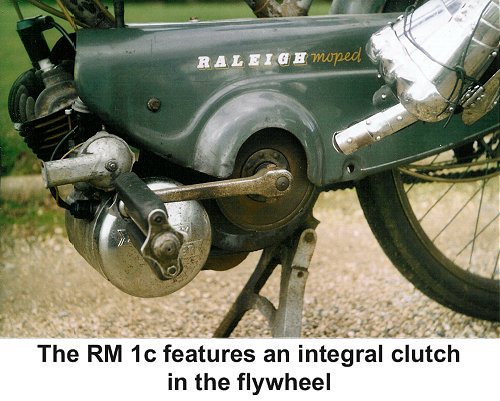
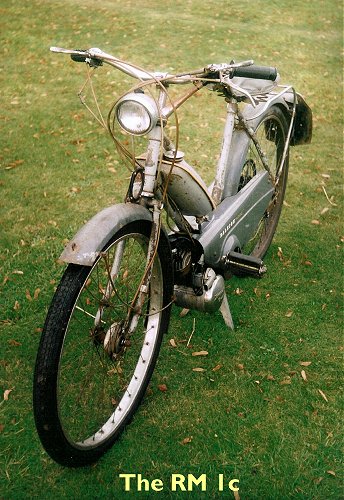
By May of 1959, Raleigh had developed the RM1c, with a clutch mounted on the belt flywheel and, though the RM1 continued on listings till December, many agents were busily retro-fitting factory conversion clutch sets free-of-charge for customers unhappy with its direct-drive. The RM1c also became de-listed in December of 1959, to be replaced by the lightly restyled RM2c in January 1960, which featured a revised colour scheme, frame trim, and 'bubble' tank to replace the oddly quaint flat tank between the frame tubes. The RM2c only lasted to October of 1960, before being succeeded by licence-built variants from Motobécane.
Raleigh's first mopeds with their Sturmey-Archer engines were a cheap and crude introduction to the market. The low cost of the RM1 & RM2 reflected in their durability. Many customers found poor reliability from the Sturmey-Archer motor, which in common with other Piatti deep-ported designs for the AMC engines, suffered badly from excessive bore wear resulting from the top-heavy piston. The decision to retail them through their cycle agent network often found the dealers lacking the training and skills to service the machines: the ultimate result of which was dissatisfied customers. Raleigh took their lesson the hard way, but learnt from the experience, going on to achieve considerable success with the following range of Motobécane based models.
Due to many RM1s receiving the retro-fit clutch conversion at the dealers, examples of the original direct-drive machine are rarely seen today - and even more rarely used!
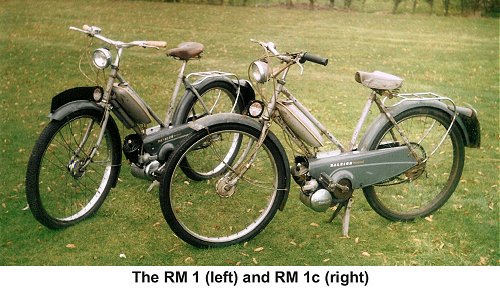
Next: We can now step through time as easily as strolling down a street but, on this occasion, it could seem like we've made a wrong turn. Jumping to September 1961, and a new moped stands on the corner of Beaver Road in Ashford, but ahead is a solid brick wall! Is this... Journey's End?
First published, December 2004